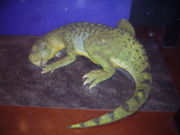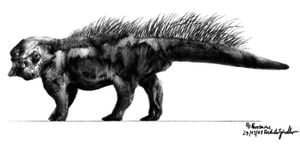Psittacosaurus
2007 Schools Wikipedia Selection. Related subjects: Dinosaurs
| iPsittacosaurus |
||||||||||||||||||
|---|---|---|---|---|---|---|---|---|---|---|---|---|---|---|---|---|---|---|
 |
||||||||||||||||||
| Scientific classification | ||||||||||||||||||
|
||||||||||||||||||
|
|
||||||||||||||||||
Osborn, 1923
Young, 1958
Sereno et al., 1988
Sereno & Zhao, 1988
Buffetaut & Suteethorn, 1992
Russell & Zhao, 1996
Russell & Zhao, 1996
Xu, 1997
Voronkevich, 1998
Zhou et al., 2006 |
||||||||||||||||||
|
|
||||||||||||||||||
|
Protiguanodon Osborn, 1923 |
Psittacosaurus ( IPA pronunciation: [,sɪ.tæ.koʊ'soʊr.əs], from the Greek for 'parrot lizard') is a genus of psittacosaurid ceratopsian dinosaur from the Early Cretaceous Period of what is now Asia, about 130 to 100 million years ago. It is notable for being the most species-rich dinosaur genus. At least eight extinct species are recognized from fossils found in different regions of China and Mongolia, with possible additional species from Thailand and Russia.
All species of Psittacosaurus were gazelle-sized bipedal herbivores characterized by a high, powerful beak on the upper jaw. At least one species had long, quill-like structures on its tail and lower back, possibly serving a display function. Psittacosaurs were extremely early ceratopsians and, while they developed many novel adaptations of their own, they also shared many anatomical features with later ceratopsians, such as Protoceratops and the elephant-sized Triceratops.
Psittacosaurus is not as familiar to the general public as its distant relative Triceratops but it is one of the most completely known dinosaur genera. Fossils of over 150 individuals have been collected so far, including many complete skeletons. Most different age classes are represented, from nestling through to adult, which has allowed several detailed studies of Psittacosaurus growth rates and reproductive biology. The abundance of this dinosaur in the fossil record has led to its use as an index fossil for Early Cretaceous sediments of central Asia.
Description
Different species of Psittacosaurus varied in size and specific features of the skull and skeleton, but shared the same overall body shape. The best-known species, P. mongoliensis, reached 2 meters (6.5 ft) in length. The maximum adult body weight was most likely over 20 kilograms (44 lb) in P. mongoliensis. Several species approached P. mongoliensis in size (P. xinjiangensis, P. neimongoliensis), while others were somewhat smaller (P. sinensis, P. meileyingensis). P. ordosensis was the smallest known species, 30% smaller than P. mongoliensis. The largest was P. lujiatunensis, which was 30% larger than P. mongoliensis.

The skull of Psittacosaurus was highly modified compared to other ornithischian dinosaurs. The skull was extremely tall and short, with an almost round profile in some species. The portion in front of the orbit (eye socket) was only 40% of total skull length, shorter than any other known ornithischian. Both upper and lower jaws sported a pronounced beak, formed from the rostral and predentary bones, respectively. The bony core of the beak may have been sheathed in keratin to provide a sharp cutting surface for cropping plant material. Psittacosaurus skulls shared several adaptations with more derived ceratopsians, such as the unique rostral bone at the tip of the upper jaw, and the widely flared jugal (cheek) bones. However, there was still no sign of the bony neck frill or prominent facial horns which would develop in later ceratopsians.
Psittacosaurus postcranial skeletons were much more typical of a "basic" bipedal ornithischian. In P. mongoliensis, similarly to other species, the forelimbs were only 58% as long as the hindlimbs, indicating that these animals were almost totally bipedal in life. There were only four digits on the hand, as opposed to the five fingers found in almost all other ornithischians (including more derived ceratopsians). Overall, the four-toed hindfoot was very similar to many other small ornithischians.
Like many psittacosaurs, Psittacosaurus had a remarkably deep skull, superficially like those of parrots.
Taxonomy
Psittacosaurus was named in 1923 by Henry Fairfield Osborn, paleontologist and president of the American Museum of Natural History (AMNH). The generic name is composed of the Greek words ψιττακος (psittakos; "parrot") and σαυρος (sauros; "lizard"), suggested by the superficially parrot-like beak of these animals and their reptilian nature.
Species of Psittacosaurus
Over a dozen species have been referred to the genus Psittacosaurus, although only eight to ten are considered valid today. This is the highest number of valid species currently assigned to any single dinosaur genus (not including birds). In contrast, most other dinosaur genera are monospecific, containing only a single known species. The difference is most likely due to quirks of the fossil record. While Psittacosaurus is known from dozens of fossil specimens, most other dinosaur species are known from far fewer, and many are represented by only a single specimen. With a very high sample size, the diversity of Psittacosaurus can be analyzed more completely than that of most dinosaur genera, resulting in the recognition of more species. Most extant animal genera are represented by multiple species, suggesting that this may have been the case for extinct dinosaur genera as well, although most of these species may not have been preserved. In addition, most dinosaurs are known solely from bones and can only be evaluated from a morphological standpoint, whereas extant species often have very similar skeletal morphology but differ in other ways which would not be preserved in the fossil record. Therefore actual species diversity may be much higher than currently recognized in this and other dinosaur genera.
- Valid Psittacosaurus species
- Psittacosaurus mongoliensis — Mongolia, northern China
- Psittacosaurus sinensis — northeastern China
- Psittacosaurus meileyingensis — north-central China
- Psittacosaurus xinjiangensis — northwestern China
- Psittacosaurus neimongoliensis — north-central China
- Psittacosaurus ordosensis — north-central China
- Psittacosaurus mazongshanensis — northwestern China
- Psittacosaurus lujiatunensis - northeastern China
- Possible Psittacosaurus species
- ?Psittacosaurus sattayaraki - Thailand
- ?Psittacosaurus sibiricus - Russia (southern Siberia)
Classification
Psittacosaurus is the type genus of the family Psittacosauridae, which was also named by Osborn in 1923. Only one other genus, Hongshanosaurus, is currently classified in this family alongside Psittacosaurus. Psittacosaurids were basal to almost all known ceratopsians except Yinlong and perhaps Chaoyangsaurus. While Psittacosauridae was an early branch of the ceratopsian family tree, Psittacosaurus itself was probably not directly ancestral to any other groups of ceratopsians. All other ceratopsians retained the fifth digit of the hand, a plesiomorphy or primitive trait, whereas all species of Psittacosaurus had only four digits on the hand. In addition, the antorbital fenestra, an opening in the skull between the eye socket and nostril, was lost during the evolution of Psittacosauridae, but is still found in most other ceratopsians and in fact most other archosaurs. It is considered highly unlikely that the fifth digit or antorbital fenestra would evolve a second time.
Provenance
Psittacosaurus is known from over 150 individual specimens, of which over 75 belong to the type species, P. mongoliensis. All Psittacosaurus fossils discovered so far have been found in Early Cretaceous sediments in Asia. The most common age of geologic formations bearing Psittacosaurus fossils is Aptian- Albian, or approximately 125 to 100 million years ago. However, specimens attributed to this genus have also been recovered from slightly older strata, such as the Yixian Formation, which is considered to date from the Hauterivian through Barremian stages of the Early Cretaceous Period, or approximately 136 to 125 million years ago. The genus may therefore have existed for more than 30 million years. Nearly all sedimentary formations of Barremian to Albian age in Mongolia and northern China have produced fossils of Psittacosaurus, leading to its use as an index fossil for the region.
Paleobiology
Psittacosaurus is extremely well-known and represented by hundreds of specimens, allowing a more detailed analysis of its life history than is possible for the vast majority of dinosaurs.
Diet
Psittacosaurs had self-sharpening teeth that would have been useful for cropping and slicing tough plant material. However, unlike later ceratopsians, they did not have teeth suitable for grinding or chewing their food. Instead, they used gastroliths, stones swallowed to wear down food as it passed through the digestive system. Gastroliths, sometimes numbering more than fifty, are occasionally found in the abdominal cavities of psittacosaurs, and may have been stored in a gizzard, as in modern birds.
Integument
The integument, or body covering, of Psittacosaurus is known from a Chinese specimen, which most likely comes from the Yixian Formation of Liaoning. The specimen, which is not yet assigned to any particular species, was illegally exported from China, in violation of Chinese law, but was purchased by a German museum and arrangements are being made to return the specimen to China.
Most of the body was covered in scales. Larger scales were arranged in irregular patterns, with numerous smaller scales occupying the spaces between them, similarly to skin impressions known from other ceratopsians, such as Chasmosaurus. However, a series of what appear to be hollow, tubular bristles, approximately 16 centimeters (6.4 in) long, were also preserved, arranged in a row down the dorsal (upper) surface of the tail. The structures appear similar to the protofeathers found on numerous theropod dinosaurs from the same formation, although they may or may not be homologous. As the structures are only found in a single row on the tail, it is unlikely that they were used for thermoregulation, but they may have been useful for communication through some sort of display.
Growth rate
Several juvenile Psittacosaurus have been found. The smallest is a P. mongoliensis hatchling in the AMNH collection, which is only 11 to 13 centimeters (4-5 in) long, with a skull 2.8 centimeters (1 in) in length. Another hatchling skull at the AMNH is only 4.6 centimeters (1.8 in) long. Both specimens are from Mongolia. Juveniles discovered in the Yixian Formation are approximately the same age as the larger AMNH specimen. Adult Psittacosaurus mongoliensis approached 2 meters (6.5 ft) in length.
A histological examination of P. mongoliensis has determined the growth rate of these animals. The smallest specimens in the study were estimated at three years old and less than 1 kilogram (2.2 lb), while the largest were nine years old and weighed almost 20 kilograms (44 lb). This indicates relatively rapid growth compared to most reptiles and marsupial mammals, but slower than modern birds and placental mammals.
Parental Care
An extremely well-preserved specimen found in the Yixian Formation of Liaoning Province, China provides some of the best evidence for parental care in dinosaurs. This specimen consists of an adult Psittacosaurus (not assigned to any particular species), which is closely associated with 34 articulated juvenile skeletons, all preserved in three dimensions. The young Psittacosaurus, all approximately the same age, are intertwined in a group underneath the adult, although all 34 skulls are positioned above the mass of bodies, as they would have been in life. This suggests that the animals were alive at the time of burial, which must have been extremely rapid, perhaps due to the collapse of a burrow.
The juvenile bones are very small but are well- ossified. This has been taken as evidence of extensive parental care, as the young must have been in the nest long enough for their bones to become ossified. The sheer number of offspring in the nest suggest that they did not all belong to the preserved adult, indicating that Psittacosaurus may have engaged in some sort of communal nesting, perhaps similar to ostriches. However, even very young psittacosaur teeth appear worn, indicating they chewed their own food and may have been precocial, although this does not rule out continued parental care.
Predation
Another fossil from the Yixian Formation provides direct evidence of Psittacosaurus as a prey animal. One skeleton of Repenomamus giganticus, a large, aquatic triconodont mammal, is preserved with the remains of a juvenile Psittacosaurus in its abdominal cavity. Several of the juvenile's bones are still articulated, indicating that the carnivorous mammal swallowed its prey in large chunks. This specimen is notable in that it is the first known example of Mesozoic mammals preying on live dinosaurs. Heavy predation on juvenile Psittacosaurus may have resulted in R-selection, the production of more numerous offspring to counteract this loss.
Related Genera
- Hongshanosaurus
- Chaoyangsaurus

